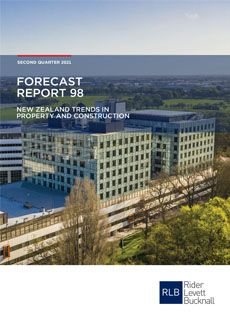According to the Rider Levett Bucknall (RLB) Forecast 98 report – New Zealand Trends in Property and Construction – construction costs across New Zealand are forecast to increase during 2021 as the long-term impacts of COVID-19 take hold.
Prepared by the New Zealand Institute of Economic Research (Inc.) (NZIER) exclusively for Rider Levett Bucknall (RLB), Forecast 98 stated that capacity pressures are intensifying in the construction sector as construction demand continues to recover strongly.
RLB Director Grant Watkins said, “There are increasing signs of capacity constraints in the New Zealand economy. In the construction sector, these constraints largely stem from labour shortages and the difficulty of firms in sourcing building materials given COVID-related supply chain disruptions.”
Building materials and shipping costs surge
“The shortage of skilled labour is particularly acute, as border restrictions limit the ability of firms to bring in workers with specialised skills from overseas. These capacity pressures, along with significantly higher shipping costs and a surge in the price of building materials such as copper and iron ore, have driven a sharp increase in construction costs,” he added.
RLB highlights the increased cost pressures facing building sector firms arising from supply chain disruptions and labour shortages. Building construction firms report the shortage of skilled labour at its most acute since the history of the survey, while a record proportion of building materials firms reported stock levels being too low.
Mr Watkins continued, “We expect these constraints, along with strengthening non-residential construction demand, will drive an increase in non-residential construction cost escalation over the coming years. We forecast annual non-residential construction cost inflation to accelerate to a peak of 5.6 per cent by March 2022 as firms pass on rising costs in the face of strong construction demand.”
Growth in construction jobs leading recovery
Stats NZ March 2021 quarter labour market data shows growth in construction jobs leading the recovery in the labour market over the past year. Continued border restrictions mean that firms will likely continue to face labour shortages, with the potential for the New Zealand-Australia quarantine-free travel bubble to exacerbate these shortages as demand in the Australian mining sector picks up.
A pick-up in job prospects in Australia will likely encourage New Zealand workers to head overseas when their current lockdowns are over. These acute capacity pressures are driving up construction costs. Reflecting the stronger demand in residential investment, this area of construction cost escalation has been strongest.
Nonetheless, the recent acceleration in the average value of non-residential consents per square metre points to non-residential cost escalation picking up as well. RLB expects that as a continued improvement in investment intentions drives non-residential construction demand this will underpin a further lift in cost escalation over the coming years.
According to Forecast 98, businesses are feeling more confident about hiring and investment. Business confidence continues to improve in New Zealand as uncertainty over further community outbreaks lessens. This is despite other major economies grappling with continued outbreaks, which has meant border restrictions remain largely in place.
House prices continue to rise
Demand for housing remains robust despite new measures targeted at taking the heat out of the housing market. This includes the extension of the bright-line test for capital gains tax and removal of interest deductibility for property investors. Recent house sales data shows the housing market remained very tight, while house prices continued to lift.
Intensifying cost pressures, including rising global commodity prices, are underpinning a lift in inflation in the New Zealand economy. As a result, focus has turned to when the Reserve Bank will start to tighten monetary policy, with the central bank’s projections indicating an OCR increase in the second half of 2022.
The property and construction sector’s longer-term outlook remains positive given the low interest rate environment is supporting demand.
FURTHER INFORMATION:



